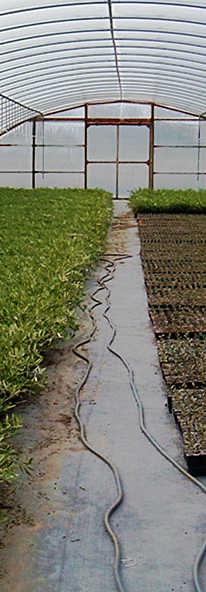
 |
|
|
OverviewWith few exceptions, only three olive varietals are utilized in Super-High-Density Orchards:Arbosana, Arbequina and Koroneiki. The major reasons for this selection are low vigor (small size necessary for efficient mechanical harvesting) and precosity. Each of these varietals are described below. See a SHD evaluation by Dr. Joan Tous.
Arbosana
The first recommended variety is ‘Arbosana’, which matures 2 weeks later and has 25% less vigour than ‘Arbequina’, is more sensitive to water stress and presents more vigourous regrowth after pruning. The oil of ‘Arbosana’ is more bitter to the taste than that of ‘Arbequina’, with a fruity and pleasant flavour. This cultivar is characterized by high productivity and resistance to low temperatures, leaf drop and olive knot (Pseudomonas savastanoi). The clone is propagated asexually and it produces 19–20% olive oil. Its leaves are small in size, 58–70 mm in length and 11–12 mm in width. The colour of the upper surface is green and that of the lower surface chrysolite green. The petiole is short, 5 mm. The fruit is early in maturation; it matures by the fourth week of October and is elliptical in shape. Composition of the oil is: palmitic acid (C 16:0), 1.3%; esteric acid (C 18:0), 2.0%; oleic acid (C 18:1), 74%; linoleic acid (C 18:2), 7.66%; polyphenols K225 (bitterness), 0.24%. The stability of this oil is 13.5 h at 120°C.
Arbequina
‘Arbequina’ is an oil-producing cultivar with high oil content, very productive, producing every year and with a high rooting ability for its leafy cuttings. A tree of medium vigor with a weeping shape, ‘Arbequina’ is very tolerant to cold, salinity and high atmospheric moisture, moderately tolerant to drought, Pseudomonas savastanoi and poorly tolerant to Bactrocera oleae, Cycloconium oleaginum, Gloesporium olivarum, Dacus Oleae (olive fly), iron chlorosis, Meloidogyne arenaria, Meloidogyne incognita, Meloidogyne javanica, Pratylenchus penetrans, Pratylenchus vulnus, Saissetia oleae and Verticillium dahliae. The yield of oil is good (20-22%), of excellent quality with good organooletic characteristics. Synonyms of this cultivar include the following: ‘Arbequin’, ‘Alberchina’, ‘Catalana, ‘Blancal’, ‘Oliva de Arbela’, ‘Manglot’, ‘Blancas’ and ‘Oliva de Borjas’. The cultivar is distributed throughout Spain, Algeria, Argentina, Australia, Bolivia, Brazil, Chile, China, France, Israel, Peru and the USA. The tree’s requirements for chilling time are low, and therefore this cultivar can be expanded in southern areas with very mild winters.
Koroneiki (Olea europaea var. microcarpa alba)
A tree of medium vigor with a spreading habitat and open canopy. Other names of this cultivar are ‘Psilolia’, ‘Lianolia’ or ‘Korani’. It is widespread in the main olive-producing districts of Greece (i.e. Crete, Peloponnese, etc.) and is expanding in other areas of the world too. In recent years this cultivar has started to be grown in the form of super-dense plantings all over the world (e.g. Australia, Italy, Spain). The leaves are thick, with a small leaf blade. The length of the blade is 4.5–5.2 cm and the ratio of length:width is 4.2–5.5:1.The fruit is very small (0.5 g), with a mastoid shape and ending in a teat. The fruit ripens from mid- to late season and turns black at full ripening. The pit is small and cylindroconical in shape. The oil content is 27% and is high in oleic acid and is very stable. The ratio of flesh:pit is 1.63–4.06:1. The medium yield per tree is 50–60 kg. This cultivar is resistant to water stress and wind, but sensitive to Dacus oleae, Euphyllura olivina, Pseudomonas savastanoi and attacks from rhynchites. Its tolerance to cold is low and its rooting ability from leafy cuttings is constant and medium.
|
|
  |











